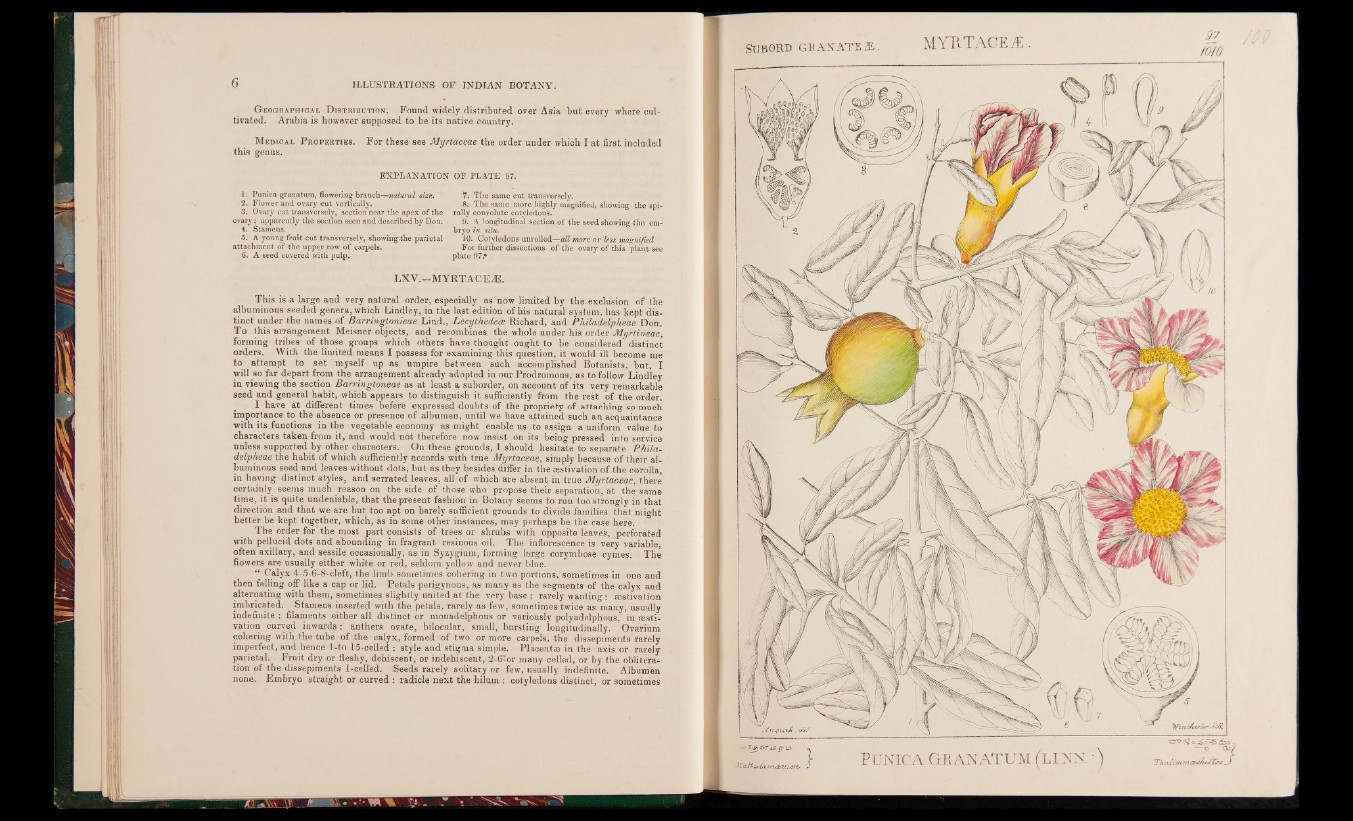
G eographical D istribution. Found widely distributed over Asia but every where cultivated.
Arabia is however supposed to be its native country.
M edical P roperties. For these see Myrtaceae the order under which I at first included
this genus.
EXPLANATION OF PLATE 97.
1. Punica granatum, flowering branch—natural size.
2. Flower and ovary cut vertically.
3. Ovary cut transversely, section near the apex o f the
ovary; apparently the section seen and described by Don.
4. Stamens.
5. A young fruit cut transversely, showing the parietal
attachment of the upper row o f carpels.
6. A seed covered with pulp.
7. The same cut transversely..
8. The same more highly magnified, showing the spirally
convolute cotyledons.
9. A longitudinal section of the seed showing the embryo
vn_$ita.
10. Cotyledons unrolled—all more or less magnified.
For further dissections o f the ovary o f this plant see
plate 97.*
LXV.—MYRTACEÆ.
This is a large and very natural order, especially as now limited by the exclusion of the
albuminous seeded genera, which Lindley, in the last edition of his natural system, has kept distinct
under the names of Barrifigtonieae Lind., Lecythedece Richard, and Philadelpheae Don.
To this arrangement Meisner objects, and recombines the whole under his order Mxyrtineae,
forming tribes of those groups which others have thought ought to be considered distinct
orders. With the limited means I possess for examining this question, it would ill become me
to attempt to set myself up as umpire between such accomplished Botanists, but, I
will so far depart from the arrangement already adopted in our Prodromous, as to follow Lindley
in viewing the section Barringtoneae as at least a suborder, on account of its very remarkable
seed and general habit, which appears to distinguish it sufficiently from the rest of the order.
I have at different times befere expressed doubts of the propriety of attaching so much
importance to the absence or presence of albumen, until we have attained such an acquaintance
with its functions in the vegetable economy as might enable us to assign a uniform value to
characters taken from it, and would not therefore now insist on its being pressed into service
unless supported by other characters. On these grounds, I should hesitate to separate Philadelpheae
the habit of which sufficiently accords with true Myrtaceae, simply because of their albuminous
seed and leaves without dots, but as they besides differ in the aestivation of the corolla,
in having distinct styles, and serrated leaves, all of which are absent in true Myrtaceae, there
certainly seems much reason on the side of those who propose their separation, at the same
time, it is quite undeniable, that the present fashion in Botany seems to run too strongly in that
direction and that we are but too apt on barely sufficient grounds to divide families that might
better be kept together, which, as in some other instances, may perhaps be the case here.
The order for the most part consists of trees or shrubs with opposite leaves, perforated
with pellucid dots and abounding infragrant resinous oil. The inflorescence is very variable,
often axillary, and sessile occasionally, as in Syzygium, forming large corymbose cymes. The
flowers are usually either white or red, seldom yellow and never blue.
“ Calyx 4-5-6-8-cleft, the limb sometimes cohering in two portions, sometimes in one and
then falling off like a cap or lid. Petals perigynous, as many as the segments of the calyx and
alternating with them, sometimes slightly united at the very base; rarely wanting : sestivation
imbricated. Stamens inserted with the petals, rarely as few, sometimes twice as many, usually
indefinite : filaments either all distinct or monadelphous or variously polyadelphous, in e stivation
curved inwards: anthers ovate, bilocular, small, bursting longitudinally. Ovarium
cohering with the tube of the calyx, formed of two or more carpels, the dissepiments rarely
imperfect, and hence 1-to 15-celled : style and stigma simple. Placentas in the axis or rarely
parietal. Fruit dry or fleshy, dehiscent, or indehiscent, 2-6-or many-celled, or by the obliteration
of the dissepiments 1-celled. Seeds rarely solitary or few, usually indefinite. Albumen
none. Embryo straight or curved : radicle next the hilum : cotyledons distinct, or sometimes
3 7
1010
PUNICA GRANATUM (LINN Tknlùnmac/uJÜâa